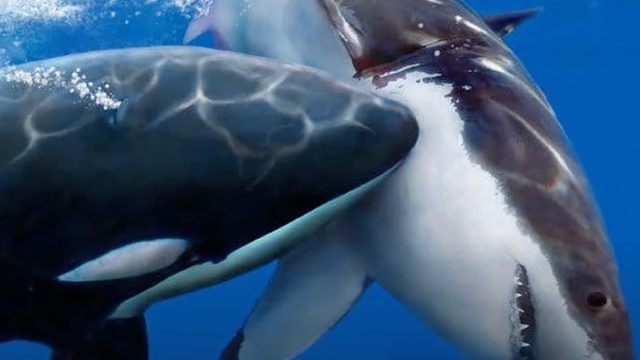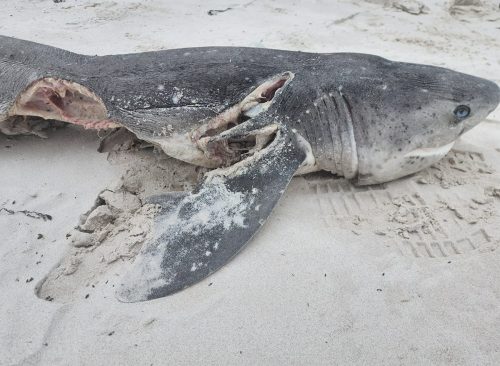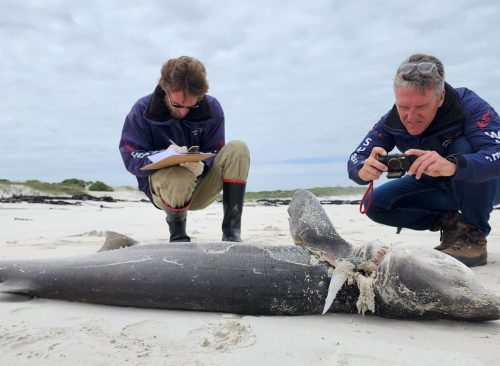Killer Whale Pair Kills 17 Sharks in a Single Day and Eats Only Their Livers
It’s not the first time that the well-known orcas have gone on the attack.

Two well-known orcas killed 17 sharks in a single day last week off the coast of South Africa, the deadliest in a yearslong series of attacks that are changing the ecology of the offshore region, scientists say. The orcas, which are also called killer whales, ate the sharks' livers but left the rest of the fish to wash ashore on Pearly Beach, more than 100 miles from Cape Town. The 17 dead sharks were all females, and two were pregnant. Here's what you need to know about this gruesome spectacle of nature.
Scientists Know the Orcas

Biologists are familiar with the two orcas, nicknamed Port and Starboard, and can identify them by their distinctive bent dorsal fins. Orcas typically attack other mammals, such as dolphins and Cape fur seals, according to Alison Kock, a marine biologist with South African National Parks. But Port and Starboard, whom scientists first observed in 2015, appear to target sharks offshore.
"We 1st observed this pair hunting sevengill sharks in False Bay, Cape Town in 2015," Kock tweeted. Port and Starboard arrived in the area off the Western Cape province. Subsequently, scuba divers found several dead sevengill sharks in the Table Mountain National Park marine protected area, home to a large group of the sharks. Named for the number of gills they have, sevengill sharks are a throwback to ancient sharks from the Jurassic era, Kock said.
"The drama didn't stop there," Kock tweeted. "In 2017 this pair then started targeting #greatwhitesharks, ultimately resulting in the sharks abandoning established aggregation sites," she added.
At least 17 sevengill #sharks have been killed by infamous #killerwhale pair Port & Starboard this week in South Africa. Only the livers were eaten with the leftover carcasses washing ashore [1/3] 📸 @MarineDynamics Christine Wessels pic.twitter.com/PQVk1KI9mF
— Dr. Alison Kock (@UrbanEdgeSharks) February 24, 2023
Why They Ate Only the Livers

"Examination of the carcasses by scientists showed that the sharks had large, gaping wounds between their pectoral fins and their livers were missing, while the rest of the internal organs like heart, stomach and reproductive organs were left behind. There were distinct bite marks on the pectoral fins of the dead sharks," Kock said in a research paper co-authored with Ph.D. student Tamlyn Engelbrecht at the University of Cape Town.
Kock added: "There were no bites anywhere else on the body, indicating that the killer whale (or whales) had likely pulled on the pectoral fins to open up the body cavity, to remove the liver. The sharks' liver accounts for up to a third of its weight and is rich in fat, a nutrient that killer whales seek out."
RELATED: 36 Latest Bone Chilling Details About the Idaho Murder Case
The Attacks Are Changing the Ecosystem

"Large, predatory sharks occupy the top of ocean food chains, where they play important roles in maintaining diverse and healthy ecosystems," Kock said. "The loss of these predators can therefore have significant impacts on ecosystems. "For a long time broadnose sevengill sharks have occupied the apex of the food chain alongside the more famous great white sharks in False Bay on the southern tip of South Africa," Kock added. As the orcas continue to attack sharks, "the increased presence of these particular killer whales in False Bay could have profound impacts throughout the ecosystem," Kock said.














